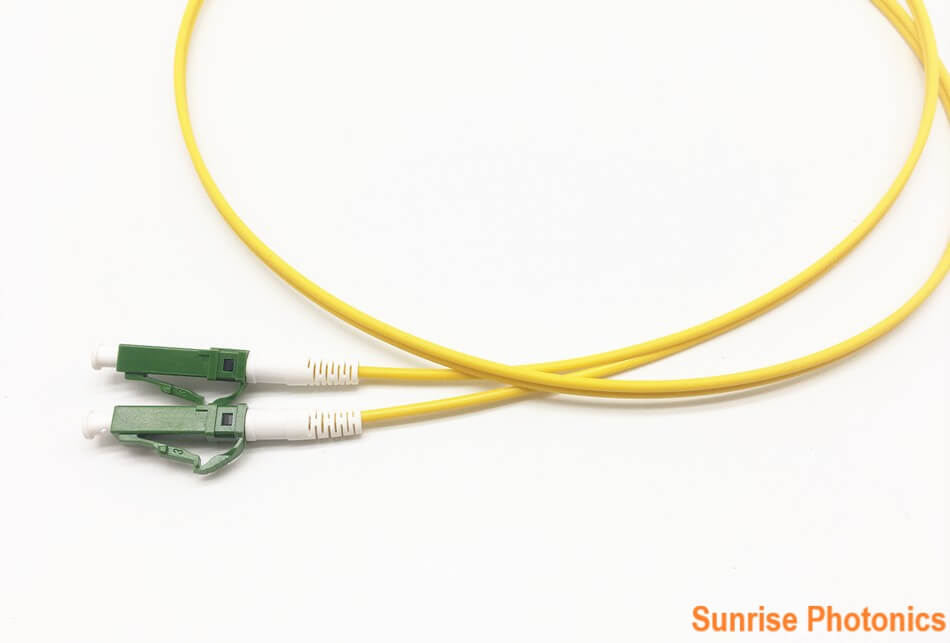Standard LC connectors are already compact connectors, but sometimes when using them in cabinets, you’ll still find that the connector body is too long because most cabinets are usually shallow. If the connector is too long, the cabinet door cannot be closed properly.
We created the LC Short to LC Short Fiber Jumper to resolve this issue. The centerline spacing of the Mini-LC duplex connector is reduced. Mini-LC fiber optic connectors minimize footprint and provide higher density port installation for data center network equipment, making them ideal for mini SFP optical transceivers.

Specifications
| Connector Type | LC to LC | Polish Type | UPC/APC |
| Fiber Mode | OS2 9/125μm | Wavelength | 1310/1550nm |
| Insertion Loss | ≤0.3dB | Return Loss | ≥50dB |
| Fiber Grade | G.657/G.652.D | Minimum Bend Radius | 10mm |
| Attenuation at 1310 nm | 0.36 dB/km | Attenuation at 1550 nm | 0.22 dB/km |
| Fiber Count | Duplex/Simplex | Cable Diameter | 2.0mm |
| Cable Jacket | PVC | Polarity | A(Tx) to B(Rx) |
| Operating Temperature | -20~80°C | Storage Temperature | -40~80°C |
G.652D is the fiber-optic fiber model in fiber optic cable, representing the non-dispersion displacement single-mode fiber, is currently the most widely used single-mode fiber. Commercially launched in 1983, its scattered wavelength at 1310nm, at 1550nm at the minimum attenuation, but there is a larger positive dispersion, about 8ps (nm/km), the working wavelength can be selected 1310nm, can also choose 1550nm.
This fiber is the most widely used fiber, most of the fiber has been laid, fiber optic cable is most of this kind of fiber. In the late 1970s, attempts were made to replace light-emitting diode light sources with developed long-life semiconductor lasers to obtain longer communication distances and greater communication capacity, but pattern noise occurs when lasers are transmitted in multimode optical fibers. In order to overcome the mode noise, in 1980 successfully developed a single-mode fiber (non-dispersive displacement single-mode fiber), referred to as standard single-mode fiber, which ITU-T recommends as G.652 fiber. Because the design idea of single-mode fiber is to transmit only one mode, there is no mode noise that occurs when transmission occurs in multimode fiber. Therefore, in the mid-1980s, 140Mbit/s optical fiber communication system consisting of laser light source and standard single-mode fiber, in which the relay distance and transmission capacity far exceeded the transmission system of coaxial cable, so that the optical fiber communication system gradually replaced the copper cable communication, becoming the main communication mode adopted in the telecommunications industry.
The G.657 access network with bending attenuation insensitive single-mode fiber optic cable characteristics” is the standard that ITU-T issued in November 2006.
G.657 Fiber is the latest fiber variety developed based on G.652 fiber to achieve the goal of fiber-to-the-home. The main characteristic of this type of fiber is its excellent bending resistance, which achieves a bending radius of 1/4 to 1/2 of the conventional G.652 fiber. G.657 fiber sub-A, B two subcategories, in which G.657A fiber performance and its application environment and G.652D type fiber similar, can be in the 1260 to 1625nm wide wavelength range (i.e. O, E, S, C, L5 working bands) work The G.657B fiber mainly works at 1310nm, 1550nm and 1625nm 3 wavelength windows, which is more suitable for the transmission of FTTH information, installation in the interior or building and other narrow places.
When there is limited space, the LC Short Start Connector is a popular fiber optic cable assembly. By using the LC short start connector, the body can be greatly reduced to fit the space to the minimum. We offer a full range of fiber jumpers that use these LC short sleeve connectors in a variety of colors and diameters.
Examples of high-density applications that require these LC short start connectors include the telephone company’s central office, CATV front end, building trunk and customer housing applications. Similar to LC short sleeves, our SC mini sleeves reduce the length of standard SC connectors compared to traditional casing designs while maintaining excellent cable support and bending radii. Both the LC Boots and the SC mini boots maintain a flexible and compact design that supports the industry’s demanding standards.
